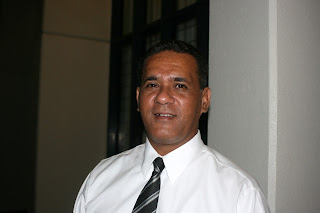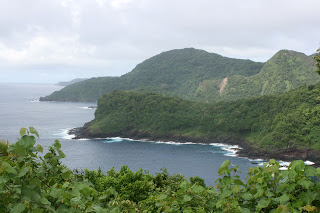On Friday morning we did another training session at Mapusaga Family History Center. We worked from 9:00 AM till a little after 1:00 PM,
getting some great work accomplished. One of the wards in the stake held a Family History camp the
day before. The leaders took a flash drive with the videos we had provided to show at this event.
People were so impressed by the videos they were very eager to come find family names right away.
Again, we felt very blessed that once we had been placed in exactly the right place at the right time to
bring a message that people were prepared to receive. It is experiences like this that show us time and
time again that the Lord is watching over us on this mission.

We were supposed to do another training with Bishops and Consultants from Pago Pago stake that
evening. However, the Stake President called us to cancel it due to the approaching storm. While we
were disappointed to not be able to hold the training we had prepared for, we agreed with the Stake
President that the safety of the members was more important. The weather at that point was typical
for our time in the islands – overcast skies with intermittent rain. However, we had reason to believe it
could soon turn much more serious.
What had been classified as merely a tropical depression out over the Pacific had picked up steam and
was now being tracked as Cyclone Amos, and it was headed our way. Each time we would check the
weather reports they kept upgrading the expected force of this storm from Category 1 to 2 then 3.
Having recently seen the terrible destruction done in Fiji by Cyclone Winston, we knew that storms in
this part of the world could be very dangerous. Many members walk long distances on the island to
come to meetings, or else ride in the open backs of pick up trucks. Not knowing what the storm would
be doing by the time we were scheduled for that meeting, it just made sense in the interest of safety to
call it off.
People on the island were preparing by gathering bottles of water, food, flashlights and batteries. Those
that had the resources to do so nailed sheets of plywood over their windows on homes and shops.
There was no extreme fear or panic, but it was clear that folks were taking the storm warnings very
seriously. A team from FEMA flew in to the island to be ready to assess storm damage should a disaster
strike. Everywhere we went we saw evidence of preparation. It reminded us of the scripture from
D&C “If ye are prepared ye shall not fear”.
That night we spent some time on the Internet reading information about the storm and wondering how
serious it would be in the area where we were. We felt relatively safe since we were staying in a well
built hotel and were away from the sea. Still, it was a little scary knowing that within a matter of a few
hours, things could change very fast depending on which path the storm took and how long it remained
over the island.


As we went to bed on Friday night we said fervent prayers for protection, not only for ourselves, but for
all the people of the islands. We spent some time quietly pondering what it means to really mean it
when we say “thy will be done” and to trust in the Lord whether things turn out well for us or not. We
were thinking a lot about the people of Fiji and all they had been through, or those in Vanuatu and other
places where there had been devastating storms despite people of faith saying the same sort of prayers
we said that night. We thought of people throughout the world who were enduring terrible hardships.
Not knowing if the storm would hit hard or pass us by made us reflect more earnestly on the plight of
refugees, of those in war zones, of those in areas of famine and all the other hardships people face in
this world. We remembered the talks we have heard from general authorities about remaining grateful
in every circumstance and determined that no matter what happened, we would put our trust in the
Lord.

The storm came over the island of Tutuila in the early hours of April 23. There were trees down n
several areas. Some roads flooded. There was damage to some houses from the high winds and sea
surge along the coast. However, the elements seemed to be tempered as the cyclone pattern stayed
tight and close, not covering as wide an area as typical for these sorts of storms. There was no loss of
life and no major devastation. We actually slept right through it. All the prayers of faith asking for
protection were definitely heard and answered. We felt the love of our family and friends who had
been concerned for us and who we knew were praying in our behalf.

Our 10:00AM training in West Stake on Saturday had also been cancelled, since Saturday was expected
to be one of the worst days of the storm. However, by that time it was all over. So the Family History
Center director called us to see if we could still come. We were delighted to do so. Many of the people
who might have otherwise attended stayed home because an announcement had been made that the
training had been cancelled. Still, those who got the word it was back on were so enthusiastic that we
were coming. We had a great training for those who came and were touched by the expressions of
appreciation from those who attended.
After the presentation we went to the Family History Center and helped several members to submit
family names. Again, we loaded the training files and showed them how to use them.
When we were done we took a drive to explore that side of the island. We walked for a while along a
pretty beach we found and picked up a few shells. We noticed more storm damage, but also saw people
out cleaning up and doing all they could to restore order. People were smiling, children playing, and life
was going on as usual. It was really a lovely day.


















































